time MERCEDES-BENZ G55AMG 2011 W463 Owner's Manual
[x] Cancel search | Manufacturer: MERCEDES-BENZ, Model Year: 2011, Model line: G55AMG, Model: MERCEDES-BENZ G55AMG 2011 W463Pages: 288, PDF Size: 11.16 MB
Page 3 of 288
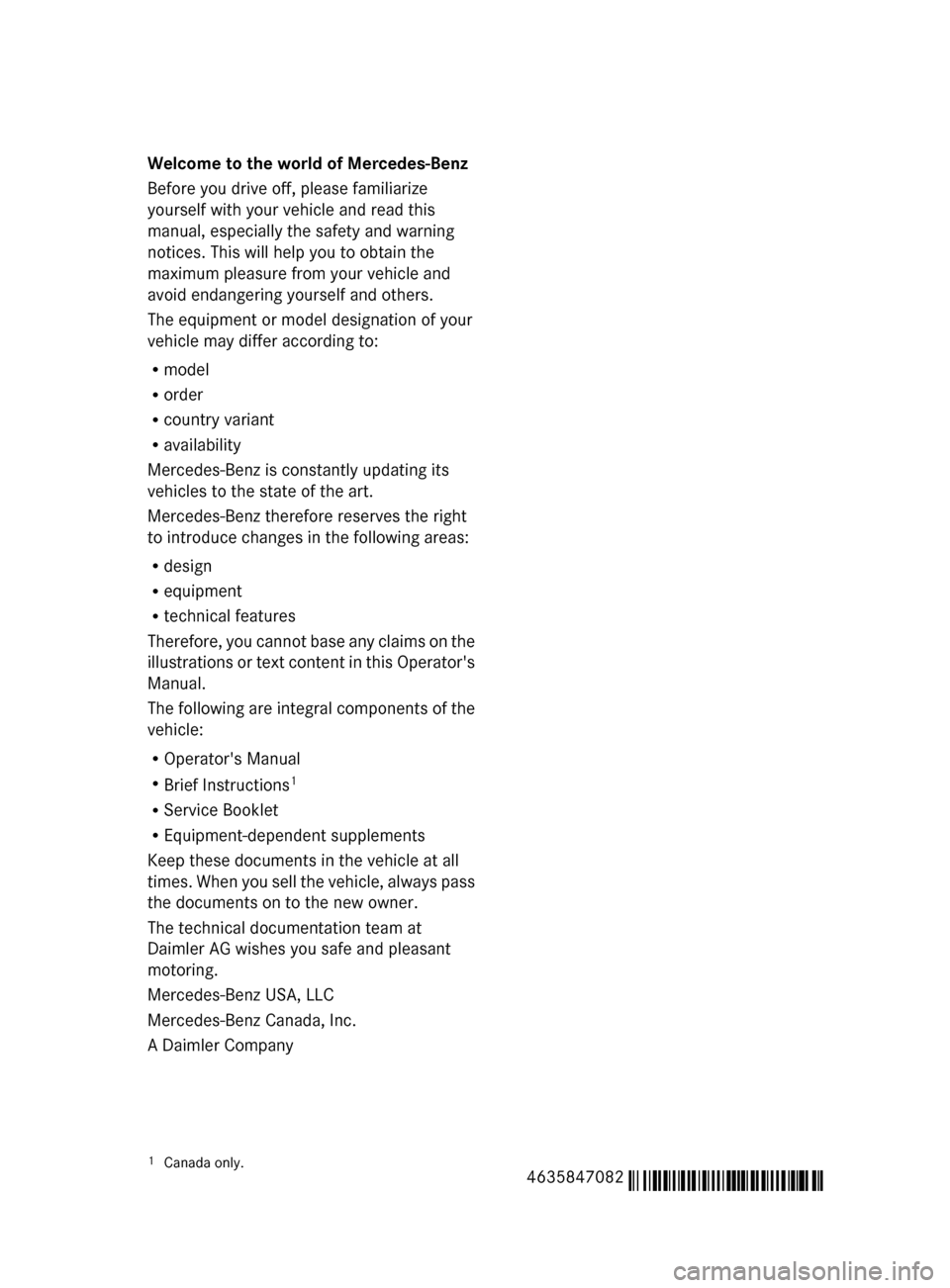
Welcome to the world of Mercedes-Benz
Before you drive off, please familiarize
yourself with your vehicle and read this
manual, especially the safety and warning
notices. This will help you to obtain the
maximum pleasure from your vehicle and
avoid endangering yourself and others.
The equipment or model designation of your
vehicle may differ according to:
R model
R order
R country variant
R availability
Mercedes-Benz is constantly updating its
vehicles to the state of the art.
Mercedes-Benz therefore reserves the right
to introduce changes in the following areas:
R design
R equipment
R technical features
Therefore, you cannot base any claims on the
illustrations or text content in this Operator's
Manual.
The following are integral components of the
vehicle:
R Operator's Manual
R Brief Instructions 1
R Service Booklet
R Equipment-dependent supplements
Keep these documents in the vehicle at all
times. When you sell the vehicle, always pass
the documents on to the new owner.
The technical documentation team at
Daimler AG wishes you safe and pleasant
motoring.
Mercedes-Benz USA, LLC
Mercedes-Benz Canada, Inc.
A Daimler Company1 Canada only.4635847082
É4635847082ÆËÍ
Page 8 of 288
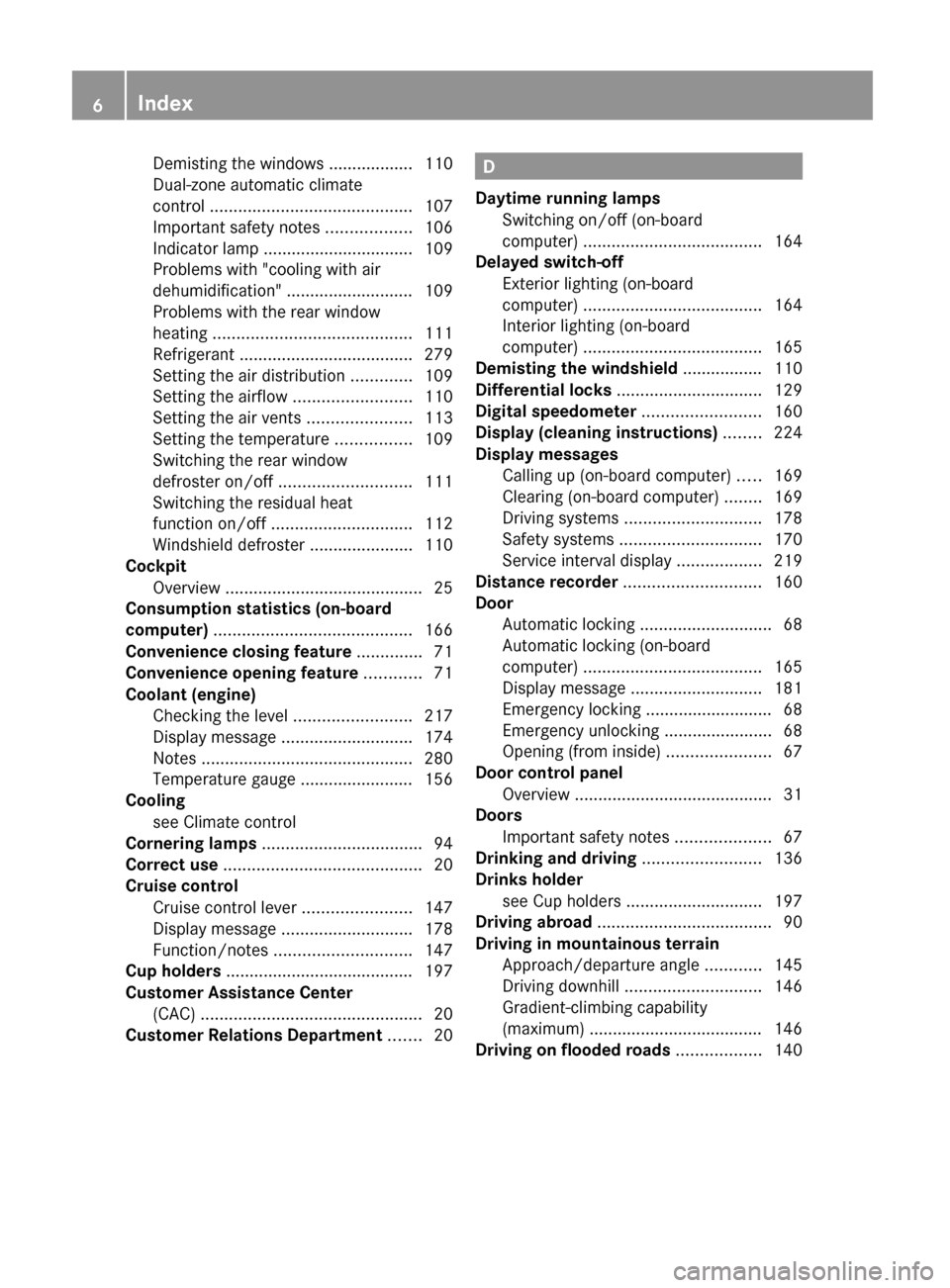
Demisting the windows .................. 110
Dual-zone automatic climate
control ........................................... 107
Important safety notes ..................106
Indicator lamp ................................ 109
Problems with "cooling with air
dehumidification" ........................... 109
Problems with the rear window
heating .......................................... 111
Refrigerant ..................................... 279
Setting the air distribution .............109
Setting the airflow .........................110
Setting the air vents ......................113
Setting the temperature ................109
Switching the rear window
defroster on/off ............................ 111
Switching the residual heat
function on/off .............................. 112
Windshield defroster ......................110
Cockpit
Overview .......................................... 25
Consumption statistics (on-board
computer) .......................................... 166
Convenience closing feature .............. 71
Convenience opening feature ............ 71
Coolant (engine) Checking the level .........................217
Display message ............................ 174
Notes ............................................. 280
Temperature gauge ........................ 156
Cooling
see Climate control
Cornering lamps .................................. 94
Correct use .......................................... 20
Cruise control Cruise control lever .......................147
Display message ............................ 178
Function/notes ............................. 147
Cup holders ........................................ 197
Customer Assistance Center (CAC) ............................................... 20
Customer Relations Department ....... 20D
Daytime running lamps Switching on/off (on-board
computer) ...................................... 164
Delayed switch-off
Exterior lighting (on-board
computer) ...................................... 164
Interior lighting (on-board
computer) ...................................... 165
Demisting the windshield ................. 110
Differential locks ............................... 129
Digital speedometer ......................... 160
Display (cleaning instructions) ........ 224
Display messages Calling up (on-board computer) .....169
Clearing (on-board computer) ........169
Driving systems ............................. 178
Safety systems .............................. 170
Service interval display ..................219
Distance recorder ............................. 160
Door Automatic locking ............................ 68
Automatic locking (on-board
computer) ...................................... 165
Display message ............................ 181
Emergency locking ........................... 68
Emergency unlocking .......................68
Opening (from inside) ......................67
Door control panel
Overview .......................................... 31
Doors
Important safety notes ....................67
Drinking and driving ......................... 136
Drinks holder see Cup holders ............................. 197
Driving abroad ..................................... 90
Driving in mountainous terrain Approach/departure angle ............145
Driving downhill ............................. 146
Gradient-climbing capability
(maximum) ..................................... 146
Driving on flooded roads .................. 1406Index
Page 11 of 288
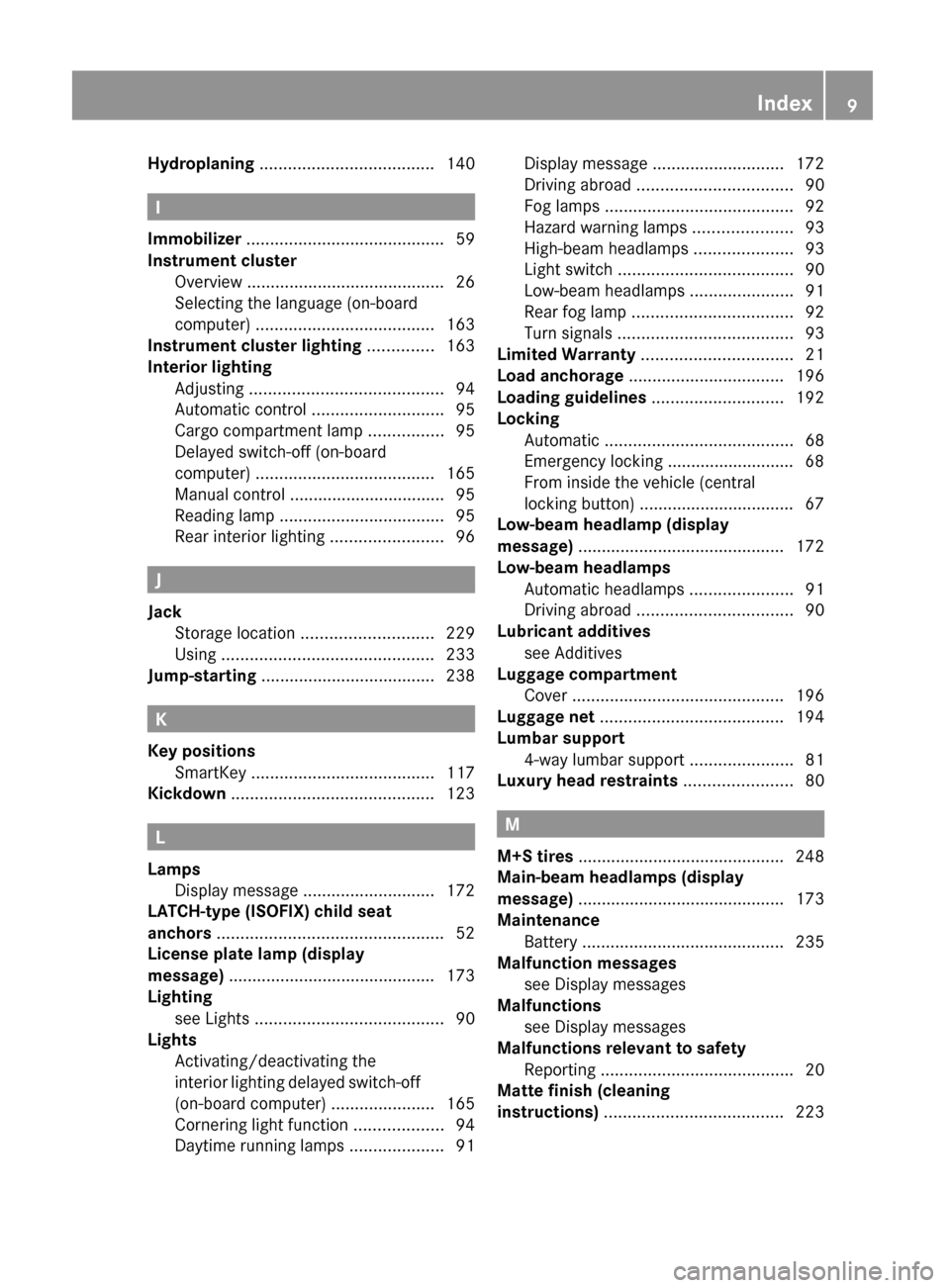
Hydroplaning ..................................... 140
I
Immobilizer .......................................... 59
Instrument cluster Overview .......................................... 26
Selecting the language (on-board
computer) ...................................... 163
Instrument cluster lighting .............. 163
Interior lighting Adjusting ......................................... 94
Automatic control ............................ 95
Cargo compartment lamp ................95
Delayed switch-off (on-board
computer) ...................................... 165
Manual control ................................. 95
Reading lamp ................................... 95
Rear interior lighting ........................96
J
Jack Storage location ............................ 229
Using ............................................. 233
Jump-starting ..................................... 238
K
Key positions SmartKey ....................................... 117
Kickdown ........................................... 123
L
Lamps Display message ............................ 172
LATCH-type (ISOFIX) child seat
anchors ................................................ 52
License plate lamp (display
message) ............................................ 173
Lighting see Lights ........................................ 90
Lights
Activating/deactivating the
interior lighting delayed switch-off
(on-board computer) ......................165
Cornering light function ...................94
Daytime running lamps ....................91
Display message ............................ 172
Driving abroad ................................. 90
Fog lamps ........................................ 92
Hazard warning lamps .....................93
High-beam headlamps .....................93
Light switch ..................................... 90
Low-beam headlamps ......................91
Rear fog lamp .................................. 92
Turn signals ..................................... 93
Limited Warranty ................................ 21
Load anchorage ................................. 196
Loading guidelines ............................ 192
Locking Automatic ........................................ 68
Emergency locking ........................... 68
From inside the vehicle (central
locking button) ................................. 67
Low-beam headlamp (display
message) ............................................ 172
Low-beam headlamps Automatic headlamps ......................91
Driving abroad ................................. 90
Lubricant additives
see Additives
Luggage compartment
Cover ............................................. 196
Luggage net ....................................... 194
Lumbar support 4-way lumbar support ......................81
Luxury head restraints ....................... 80
M
M+S tires ............................................ 248
Main-beam headlamps (display
message) ............................................ 173
Maintenance Battery ........................................... 235
Malfunction messages
see Display messages
Malfunctions
see Display messages
Malfunctions relevant to safety
Reporting ......................................... 20
Matte finish (cleaning
instructions) ...................................... 223
Index9
Page 19 of 288
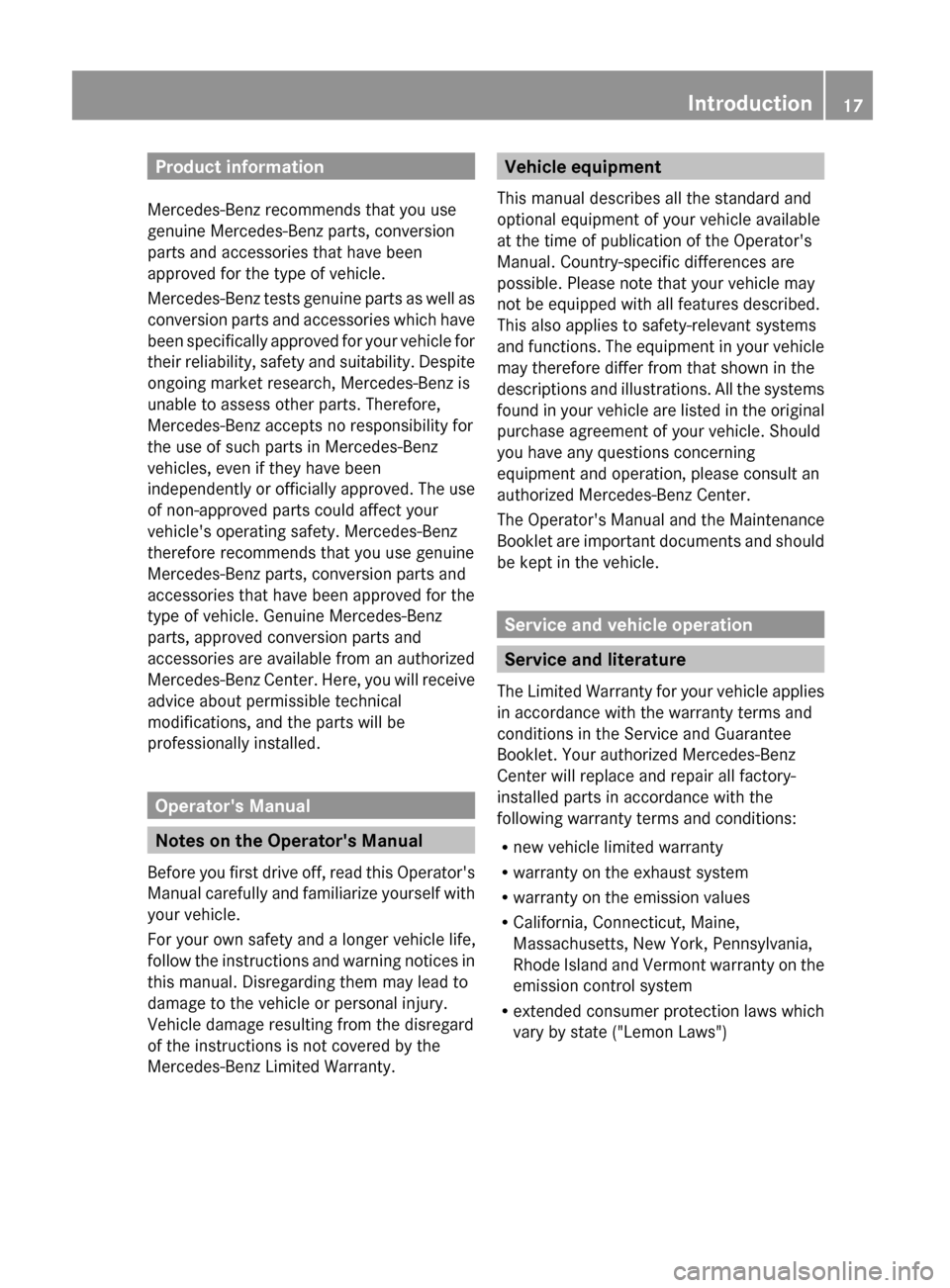
Product information
Mercedes-Benz recommends that you use
genuine Mercedes-Benz parts, conversion
parts and accessories that have been
approved for the type of vehicle.
Mercedes-Benz tests genuine parts as well as
conversion parts and accessories which have
been specifically approved for your vehicle for
their reliability, safety and suitability. Despite
ongoing market research, Mercedes-Benz is
unable to assess other parts. Therefore,
Mercedes-Benz accepts no responsibility for
the use of such parts in Mercedes-Benz
vehicles, even if they have been
independently or officially approved. The use
of non-approved parts could affect your
vehicle's operating safety. Mercedes-Benz
therefore recommends that you use genuine
Mercedes-Benz parts, conversion parts and
accessories that have been approved for the
type of vehicle. Genuine Mercedes-Benz
parts, approved conversion parts and
accessories are available from an authorized
Mercedes-Benz Center. Here, you will receive
advice about permissible technical
modifications, and the parts will be
professionally installed.
Operator's Manual
Notes on the Operator's Manual
Before you first drive off, read this Operator's
Manual carefully and familiarize yourself with
your vehicle.
For your own safety and a longer vehicle life,
follow the instructions and warning notices in
this manual. Disregarding them may lead to
damage to the vehicle or personal injury.
Vehicle damage resulting from the disregard
of the instructions is not covered by the
Mercedes-Benz Limited Warranty.
Vehicle equipment
This manual describes all the standard and
optional equipment of your vehicle available
at the time of publication of the Operator's
Manual. Country-specific differences are
possible. Please note that your vehicle may
not be equipped with all features described.
This also applies to safety-relevant systems
and functions. The equipment in your vehicle
may therefore differ from that shown in the
descriptions and illustrations. All the systems
found in your vehicle are listed in the original
purchase agreement of your vehicle. Should
you have any questions concerning
equipment and operation, please consult an
authorized Mercedes-Benz Center.
The Operator's Manual and the Maintenance
Booklet are important documents and should
be kept in the vehicle.
Service and vehicle operation
Service and literature
The Limited Warranty for your vehicle applies
in accordance with the warranty terms and
conditions in the Service and Guarantee
Booklet. Your authorized Mercedes-Benz
Center will replace and repair all factory-
installed parts in accordance with the
following warranty terms and conditions:
R new vehicle limited warranty
R warranty on the exhaust system
R warranty on the emission values
R California, Connecticut, Maine,
Massachusetts, New York, Pennsylvania,
Rhode Island and Vermont warranty on the
emission control system
R extended consumer protection laws which
vary by state ("Lemon Laws")
Introduction17
Page 20 of 288
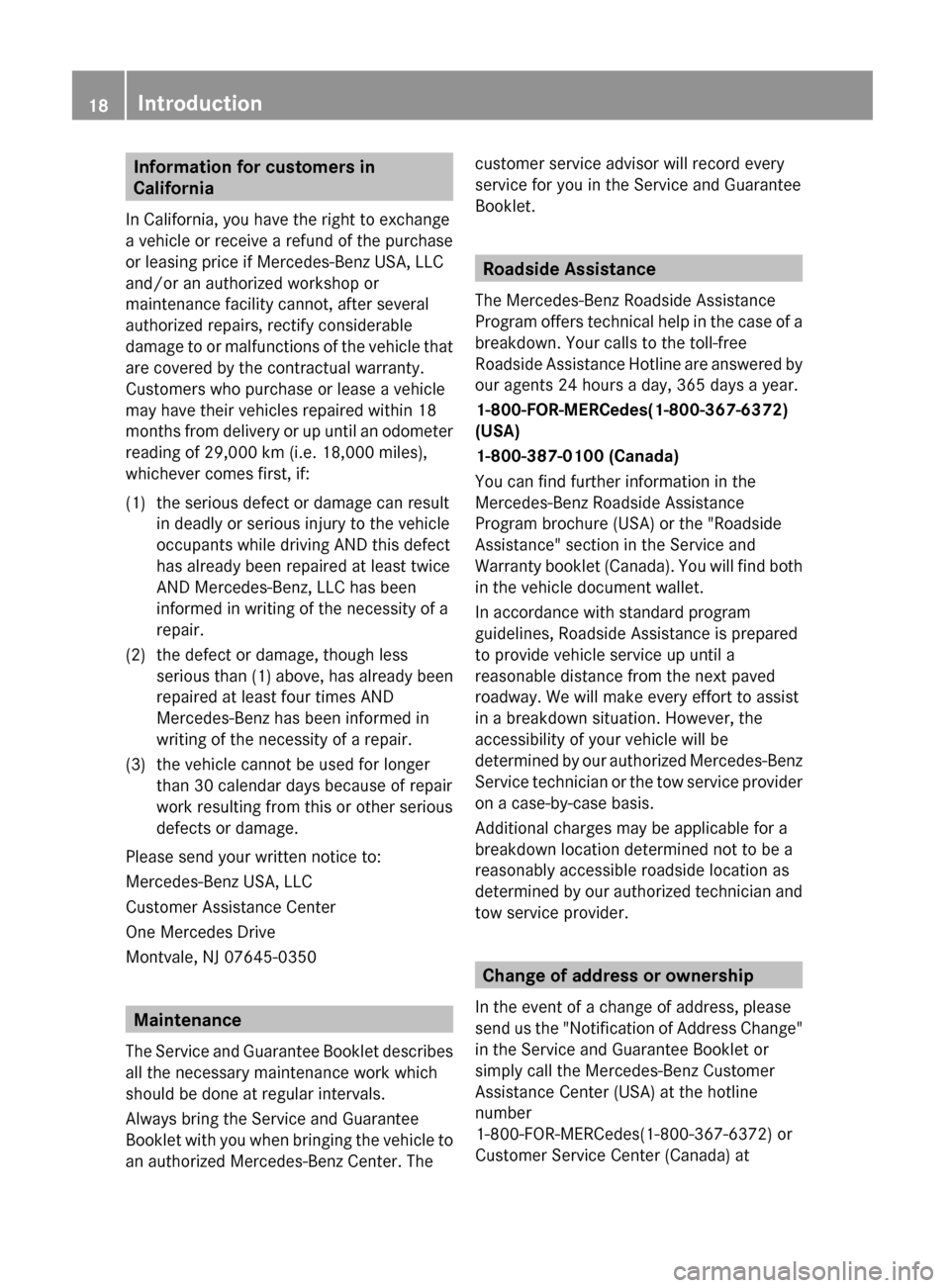
Information for customers in
California
In California, you have the right to exchange
a vehicle or receive a refund of the purchase
or leasing price if Mercedes-Benz USA, LLC
and/or an authorized workshop or
maintenance facility cannot, after several
authorized repairs, rectify considerable
damage to or malfunctions of the vehicle that
are covered by the contractual warranty.
Customers who purchase or lease a vehicle
may have their vehicles repaired within 18
months from delivery or up until an odometer
reading of 29,000 km (i.e. 18,000 miles),
whichever comes first, if:(1)the serious defect or damage can result
in deadly or serious injury to the vehicle
occupants while driving AND this defect
has already been repaired at least twice
AND Mercedes-Benz, LLC has been
informed in writing of the necessity of a
repair.(2)the defect or damage, though less
serious than (1) above, has already been
repaired at least four times AND
Mercedes-Benz has been informed in
writing of the necessity of a repair.(3)the vehicle cannot be used for longer
than 30 calendar days because of repair
work resulting from this or other serious
defects or damage.
Please send your written notice to:
Mercedes-Benz USA, LLC
Customer Assistance Center
One Mercedes Drive
Montvale, NJ 07645-0350
Maintenance
The Service and Guarantee Booklet describes
all the necessary maintenance work which
should be done at regular intervals.
Always bring the Service and Guarantee
Booklet with you when bringing the vehicle to
an authorized Mercedes-Benz Center. The
customer service advisor will record every
service for you in the Service and Guarantee
Booklet.
Roadside Assistance
The Mercedes-Benz Roadside Assistance
Program offers technical help in the case of a
breakdown. Your calls to the toll-free
Roadside Assistance Hotline are answered by
our agents 24 hours a day, 365 days a year.
1-800-FOR-MERCedes(1-800-367-6372)
(USA)
1-800-387-0100 (Canada)
You can find further information in the
Mercedes-Benz Roadside Assistance
Program brochure (USA) or the "Roadside
Assistance" section in the Service and
Warranty booklet (Canada). You will find both
in the vehicle document wallet.
In accordance with standard program
guidelines, Roadside Assistance is prepared
to provide vehicle service up until a
reasonable distance from the next paved
roadway. We will make every effort to assist
in a breakdown situation. However, the
accessibility of your vehicle will be
determined by our authorized Mercedes-Benz
Service technician or the tow service provider
on a case-by-case basis.
Additional charges may be applicable for a
breakdown location determined not to be a
reasonably accessible roadside location as
determined by our authorized technician and
tow service provider.
Change of address or ownership
In the event of a change of address, please
send us the "Notification of Address Change"
in the Service and Guarantee Booklet or
simply call the Mercedes-Benz Customer
Assistance Center (USA) at the hotline
number
1-800-FOR-MERCedes(1-800-367-6372) or
Customer Service Center (Canada) at
18Introduction
Page 21 of 288
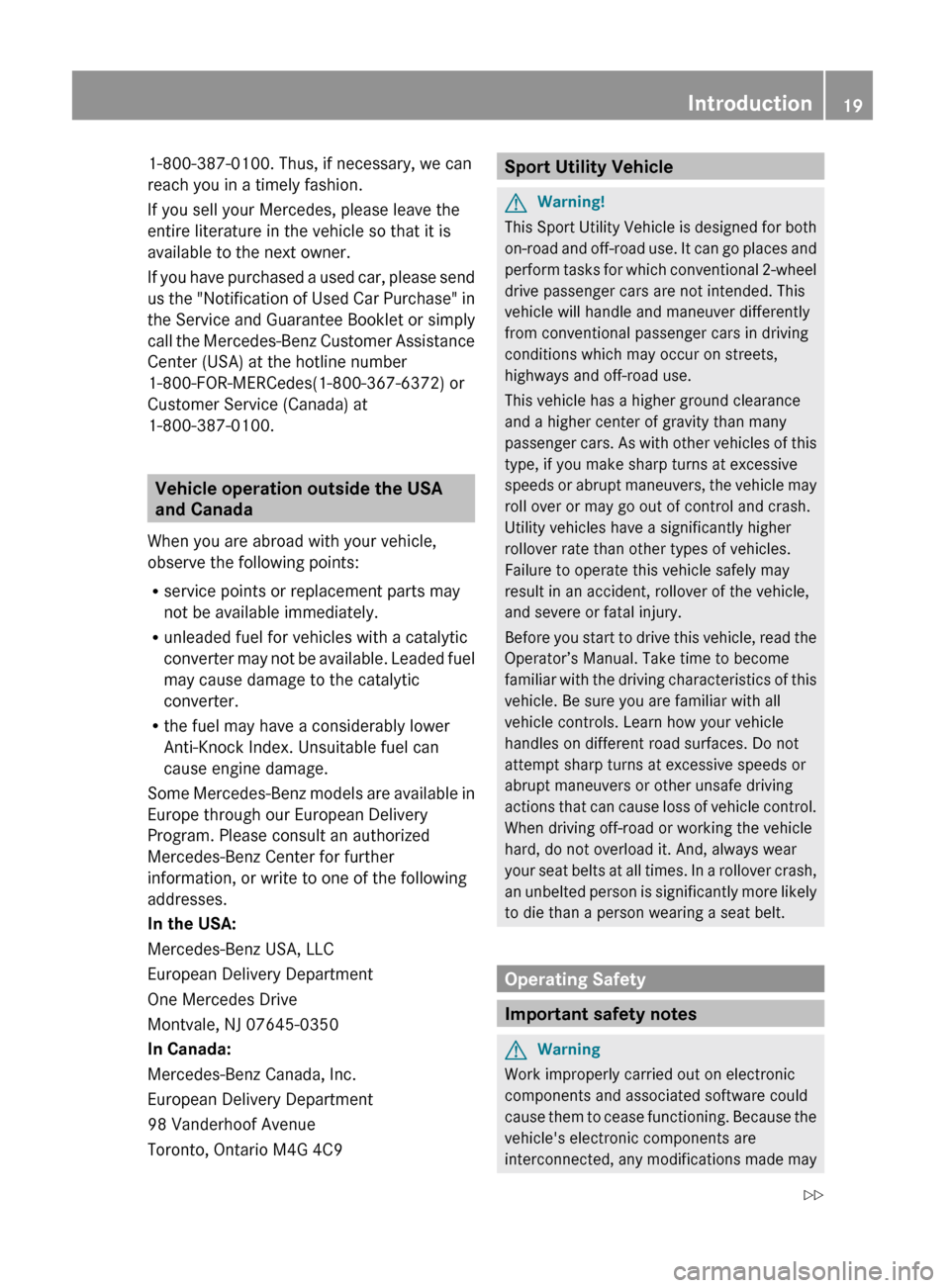
1-800-387-0100. Thus, if necessary, we can
reach you in a timely fashion.
If you sell your Mercedes, please leave the
entire literature in the vehicle so that it is
available to the next owner.
If you have purchased a used car, please send
us the "Notification of Used Car Purchase" in
the Service and Guarantee Booklet or simply
call the Mercedes-Benz Customer Assistance
Center (USA) at the hotline number
1-800-FOR-MERCedes(1-800-367-6372) or
Customer Service (Canada) at
1-800-387-0100.
Vehicle operation outside the USA
and Canada
When you are abroad with your vehicle,
observe the following points:
R service points or replacement parts may
not be available immediately.
R unleaded fuel for vehicles with a catalytic
converter may not be available. Leaded fuel
may cause damage to the catalytic
converter.
R the fuel may have a considerably lower
Anti-Knock Index. Unsuitable fuel can
cause engine damage.
Some Mercedes-Benz models are available in
Europe through our European Delivery
Program. Please consult an authorized
Mercedes-Benz Center for further
information, or write to one of the following
addresses.
In the USA:
Mercedes-Benz USA, LLC
European Delivery Department
One Mercedes Drive
Montvale, NJ 07645-0350
In Canada:
Mercedes-Benz Canada, Inc.
European Delivery Department
98 Vanderhoof Avenue
Toronto, Ontario M4G 4C9
Sport Utility VehicleGWarning!
This Sport Utility Vehicle is designed for both
on-road and off-road use. It can go places and
perform tasks for which conventional 2-wheel
drive passenger cars are not intended. This
vehicle will handle and maneuver differently
from conventional passenger cars in driving
conditions which may occur on streets,
highways and off-road use.
This vehicle has a higher ground clearance
and a higher center of gravity than many
passenger cars. As with other vehicles of this
type, if you make sharp turns at excessive
speeds or abrupt maneuvers, the vehicle may
roll over or may go out of control and crash.
Utility vehicles have a significantly higher
rollover rate than other types of vehicles.
Failure to operate this vehicle safely may
result in an accident, rollover of the vehicle,
and severe or fatal injury.
Before you start to drive this vehicle, read the
Operator’s Manual. Take time to become
familiar with the driving characteristics of this
vehicle. Be sure you are familiar with all
vehicle controls. Learn how your vehicle
handles on different road surfaces. Do not
attempt sharp turns at excessive speeds or
abrupt maneuvers or other unsafe driving
actions that can cause loss of vehicle control.
When driving off-road or working the vehicle
hard, do not overload it. And, always wear
your seat belts at all times. In a rollover crash,
an unbelted person is significantly more likely
to die than a person wearing a seat belt.
Operating Safety
Important safety notes
GWarning
Work improperly carried out on electronic
components and associated software could
cause them to cease functioning. Because the
vehicle's electronic components are
interconnected, any modifications made may
Introduction19Z
Page 36 of 288
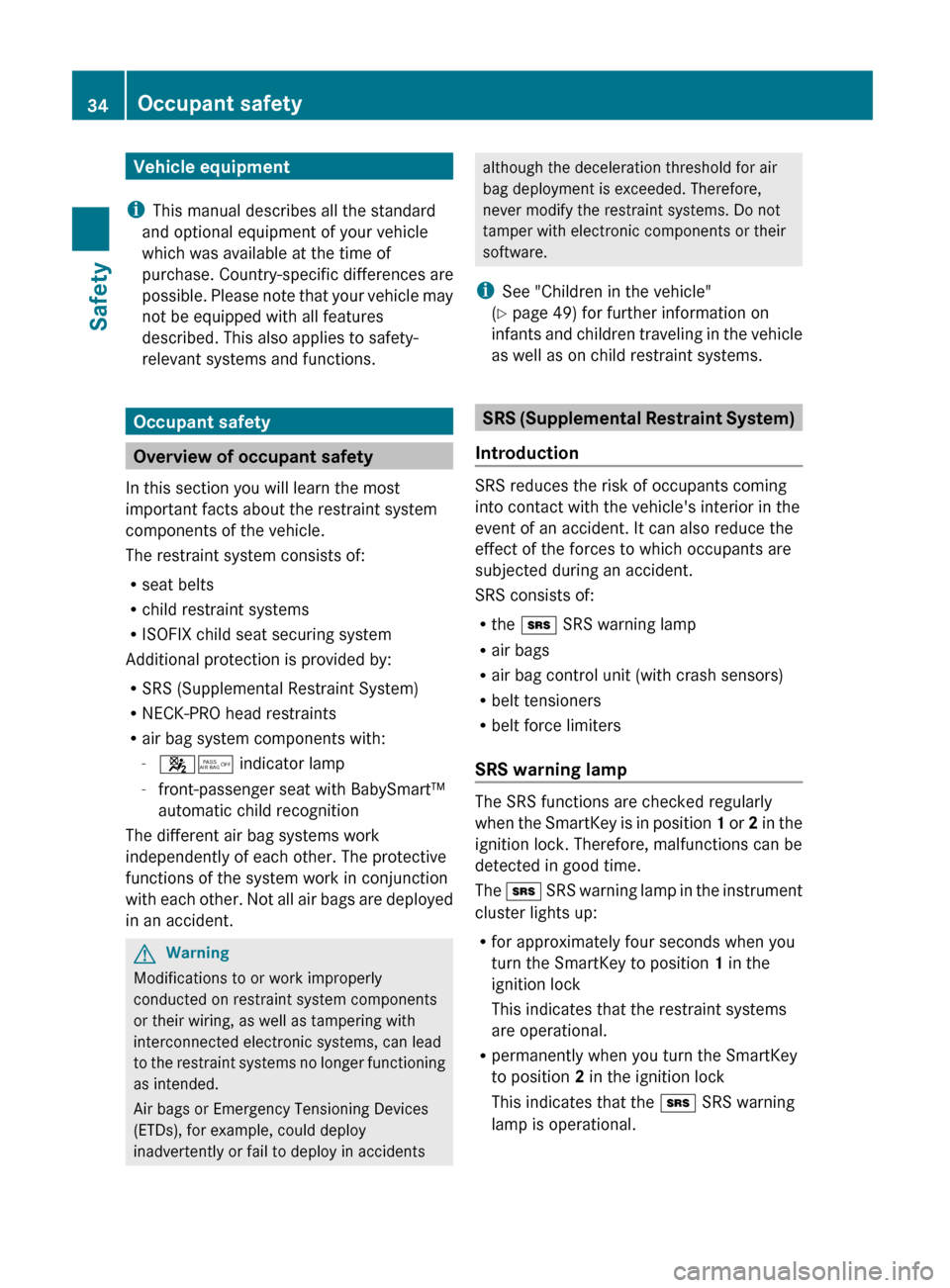
Vehicle equipment
i This manual describes all the standard
and optional equipment of your vehicle
which was available at the time of
purchase. Country-specific differences are
possible. Please note that your vehicle may
not be equipped with all features
described. This also applies to safety-
relevant systems and functions.
Occupant safety
Overview of occupant safety
In this section you will learn the most
important facts about the restraint system
components of the vehicle.
The restraint system consists of:
R seat belts
R child restraint systems
R ISOFIX child seat securing system
Additional protection is provided by:
R SRS (Supplemental Restraint System)
R NECK-PRO head restraints
R air bag system components with:
- 45 indicator lamp
- front-passenger seat with BabySmart™
automatic child recognition
The different air bag systems work
independently of each other. The protective
functions of the system work in conjunction
with each other. Not all air bags are deployed
in an accident.
GWarning
Modifications to or work improperly
conducted on restraint system components
or their wiring, as well as tampering with
interconnected electronic systems, can lead
to the restraint systems no longer functioning
as intended.
Air bags or Emergency Tensioning Devices
(ETDs), for example, could deploy
inadvertently or fail to deploy in accidents
although the deceleration threshold for air
bag deployment is exceeded. Therefore,
never modify the restraint systems. Do not
tamper with electronic components or their
software.
i See "Children in the vehicle"
( Y page 49) for further information on
infants and children traveling in the vehicle
as well as on child restraint systems.
SRS (Supplemental Restraint System)
Introduction
SRS reduces the risk of occupants coming
into contact with the vehicle's interior in the
event of an accident. It can also reduce the
effect of the forces to which occupants are
subjected during an accident.
SRS consists of:
R the + SRS warning lamp
R air bags
R air bag control unit (with crash sensors)
R belt tensioners
R belt force limiters
SRS warning lamp
The SRS functions are checked regularly
when the SmartKey is in position 1 or 2 in the
ignition lock. Therefore, malfunctions can be
detected in good time.
The + SRS warning lamp in the instrument
cluster lights up:
R for approximately four seconds when you
turn the SmartKey to position 1 in the
ignition lock
This indicates that the restraint systems
are operational.
R permanently when you turn the SmartKey
to position 2 in the ignition lock
This indicates that the + SRS warning
lamp is operational.
34Occupant safetySafety
Page 37 of 288
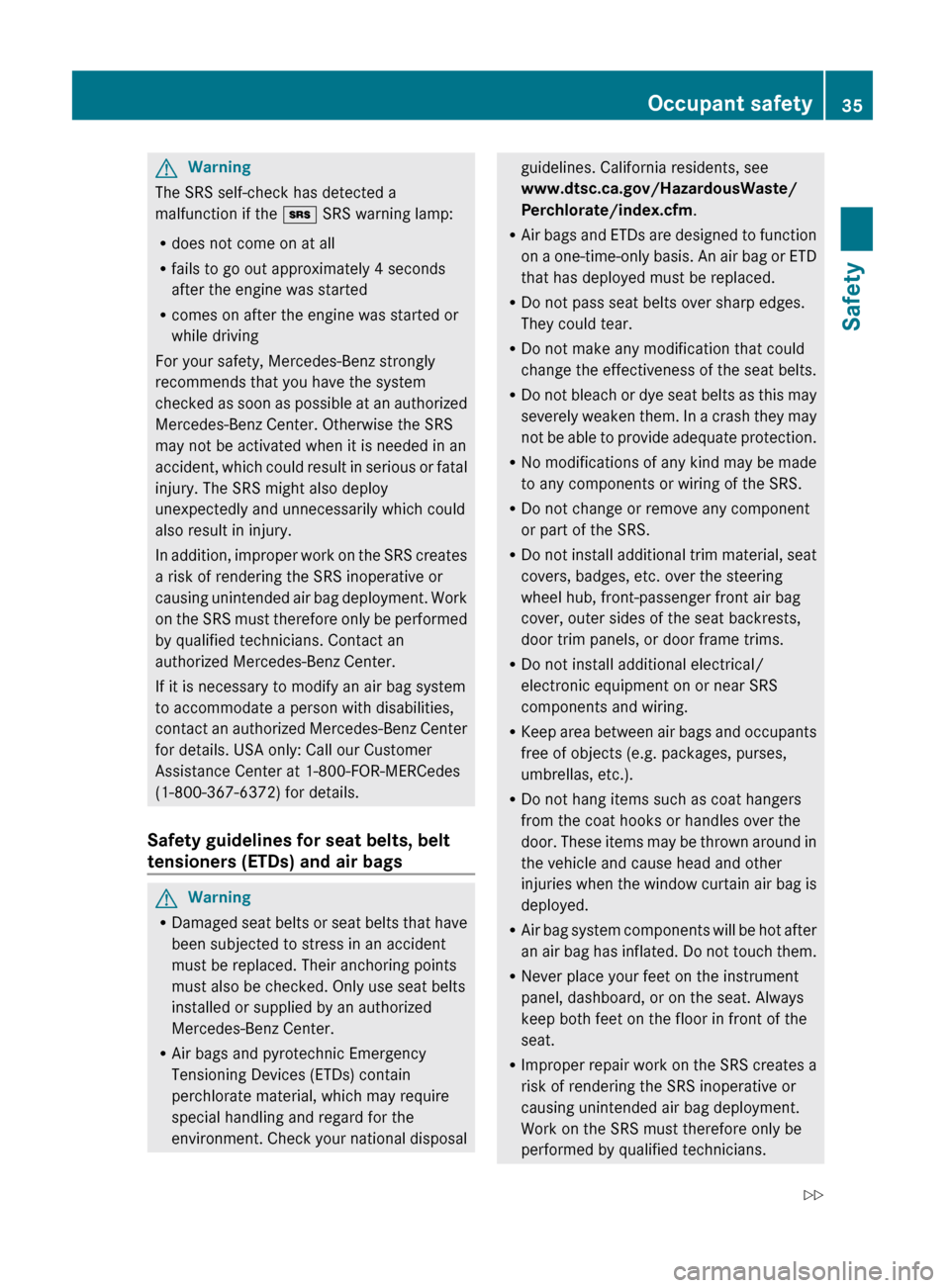
GWarning
The SRS self-check has detected a
malfunction if the + SRS warning lamp:
R does not come on at all
R fails to go out approximately 4 seconds
after the engine was started
R comes on after the engine was started or
while driving
For your safety, Mercedes-Benz strongly
recommends that you have the system
checked as soon as possible at an authorized
Mercedes-Benz Center. Otherwise the SRS
may not be activated when it is needed in an
accident, which could result in serious or fatal
injury. The SRS might also deploy
unexpectedly and unnecessarily which could
also result in injury.
In addition, improper work on the SRS creates
a risk of rendering the SRS inoperative or
causing unintended air bag deployment. Work
on the SRS must therefore only be performed
by qualified technicians. Contact an
authorized Mercedes-Benz Center.
If it is necessary to modify an air bag system
to accommodate a person with disabilities,
contact an authorized Mercedes-Benz Center
for details. USA only: Call our Customer
Assistance Center at 1-800-FOR-MERCedes
(1-800-367-6372) for details.
Safety guidelines for seat belts, belt
tensioners (ETDs) and air bags
GWarning
R Damaged seat belts or seat belts that have
been subjected to stress in an accident
must be replaced. Their anchoring points
must also be checked. Only use seat belts
installed or supplied by an authorized
Mercedes-Benz Center.
R Air bags and pyrotechnic Emergency
Tensioning Devices (ETDs) contain
perchlorate material, which may require
special handling and regard for the
environment. Check your national disposal
guidelines. California residents, see
www.dtsc.ca.gov/HazardousWaste/
Perchlorate/index.cfm .
R Air bags and ETDs are designed to function
on a one-time-only basis. An air bag or ETD
that has deployed must be replaced.
R Do not pass seat belts over sharp edges.
They could tear.
R Do not make any modification that could
change the effectiveness of the seat belts.
R Do not bleach or dye seat belts as this may
severely weaken them. In a crash they may
not be able to provide adequate protection.
R No modifications of any kind may be made
to any components or wiring of the SRS.
R Do not change or remove any component
or part of the SRS.
R Do not install additional trim material, seat
covers, badges, etc. over the steering
wheel hub, front-passenger front air bag
cover, outer sides of the seat backrests,
door trim panels, or door frame trims.
R Do not install additional electrical/
electronic equipment on or near SRS
components and wiring.
R Keep area between air bags and occupants
free of objects (e.g. packages, purses,
umbrellas, etc.).
R Do not hang items such as coat hangers
from the coat hooks or handles over the
door. These items may be thrown around in
the vehicle and cause head and other
injuries when the window curtain air bag is
deployed.
R Air bag system components will be hot after
an air bag has inflated. Do not touch them.
R Never place your feet on the instrument
panel, dashboard, or on the seat. Always
keep both feet on the floor in front of the
seat.
R Improper repair work on the SRS creates a
risk of rendering the SRS inoperative or
causing unintended air bag deployment.
Work on the SRS must therefore only be
performed by qualified technicians.Occupant safety35SafetyZ
Page 42 of 288
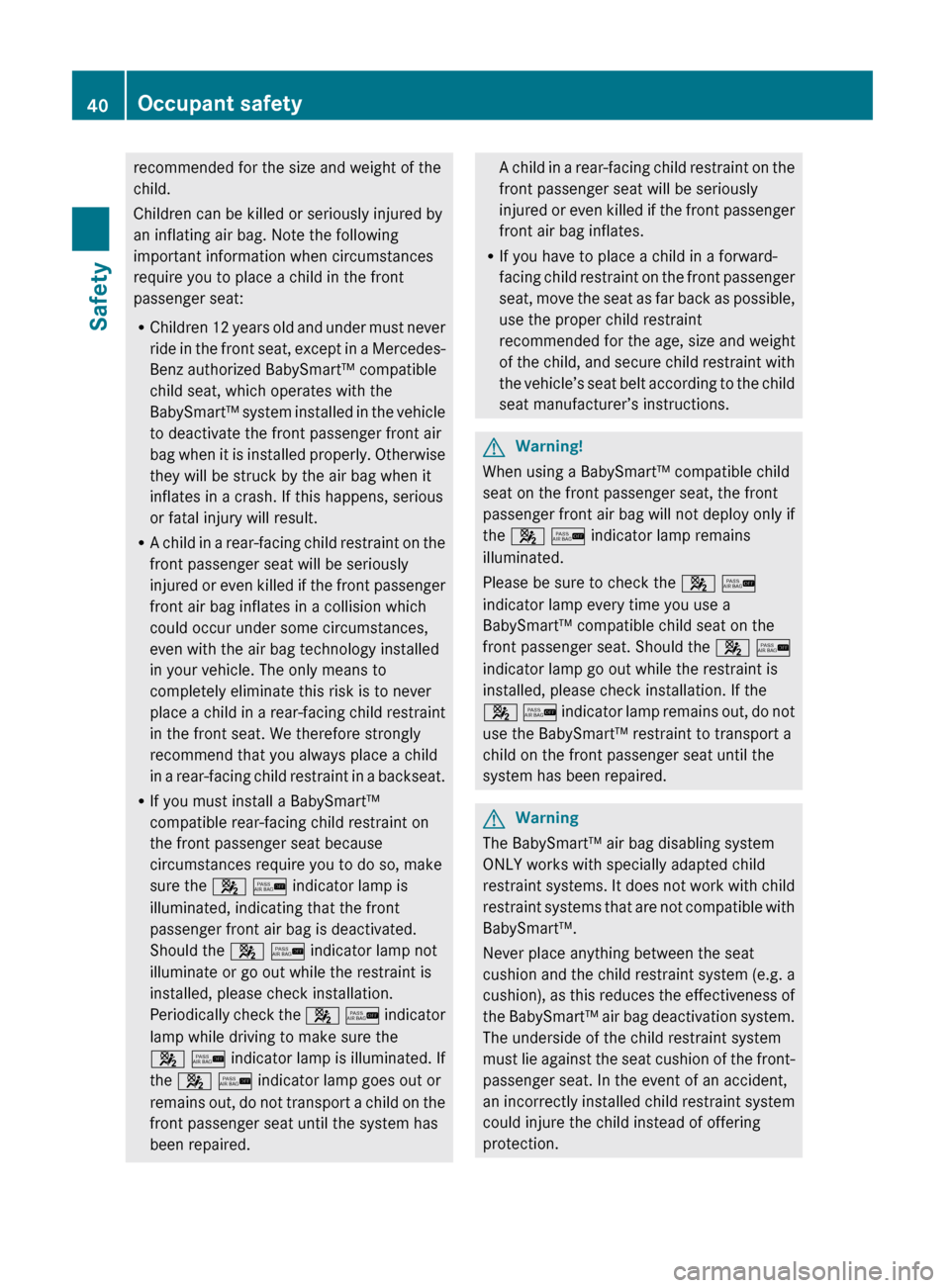
recommended for the size and weight of the
child.
Children can be killed or seriously injured by
an inflating air bag. Note the following
important information when circumstances
require you to place a child in the front
passenger seat:
R Children 12 years old and under must never
ride in the front seat, except in a Mercedes-
Benz authorized BabySmart™ compatible
child seat, which operates with the
BabySmart™ system installed in the vehicle
to deactivate the front passenger front air
bag when it is installed properly. Otherwise
they will be struck by the air bag when it
inflates in a crash. If this happens, serious
or fatal injury will result.
R A child in a rear-facing child restraint on the
front passenger seat will be seriously
injured or even killed if the front passenger
front air bag inflates in a collision which
could occur under some circumstances,
even with the air bag technology installed
in your vehicle. The only means to
completely eliminate this risk is to never
place a child in a rear-facing child restraint
in the front seat. We therefore strongly
recommend that you always place a child
in a rear-facing child restraint in a backseat.
R If you must install a BabySmart™
compatible rear-facing child restraint on
the front passenger seat because
circumstances require you to do so, make
sure the 4 / indicator lamp is
illuminated, indicating that the front
passenger front air bag is deactivated.
Should the 4 / indicator lamp not
illuminate or go out while the restraint is
installed, please check installation.
Periodically check the 4 / indicator
lamp while driving to make sure the
4 / indicator lamp is illuminated. If
the 4 / indicator lamp goes out or
remains out, do not transport a child on the
front passenger seat until the system has
been repaired.A child in a rear-facing child restraint on the
front passenger seat will be seriously
injured or even killed if the front passenger
front air bag inflates.
R If you have to place a child in a forward-
facing child restraint on the front passenger
seat, move the seat as far back as possible,
use the proper child restraint
recommended for the age, size and weight
of the child, and secure child restraint with
the vehicle’s seat belt according to the child
seat manufacturer’s instructions.GWarning!
When using a BabySmart™ compatible child
seat on the front passenger seat, the front
passenger front air bag will not deploy only if
the 4 / indicator lamp remains
illuminated.
Please be sure to check the 4 /
indicator lamp every time you use a
BabySmart™ compatible child seat on the
front passenger seat. Should the 4 /
indicator lamp go out while the restraint is
installed, please check installation. If the
4 / indicator lamp remains out, do not
use the BabySmart™ restraint to transport a
child on the front passenger seat until the
system has been repaired.
GWarning
The BabySmart™ air bag disabling system
ONLY works with specially adapted child
restraint systems. It does not work with child
restraint systems that are not compatible with
BabySmart™.
Never place anything between the seat
cushion and the child restraint system (e.g. a
cushion), as this reduces the effectiveness of
the BabySmart™ air bag deactivation system.
The underside of the child restraint system
must lie against the seat cushion of the front-
passenger seat. In the event of an accident,
an incorrectly installed child restraint system
could injure the child instead of offering
protection.
40Occupant safetySafety
Page 46 of 288
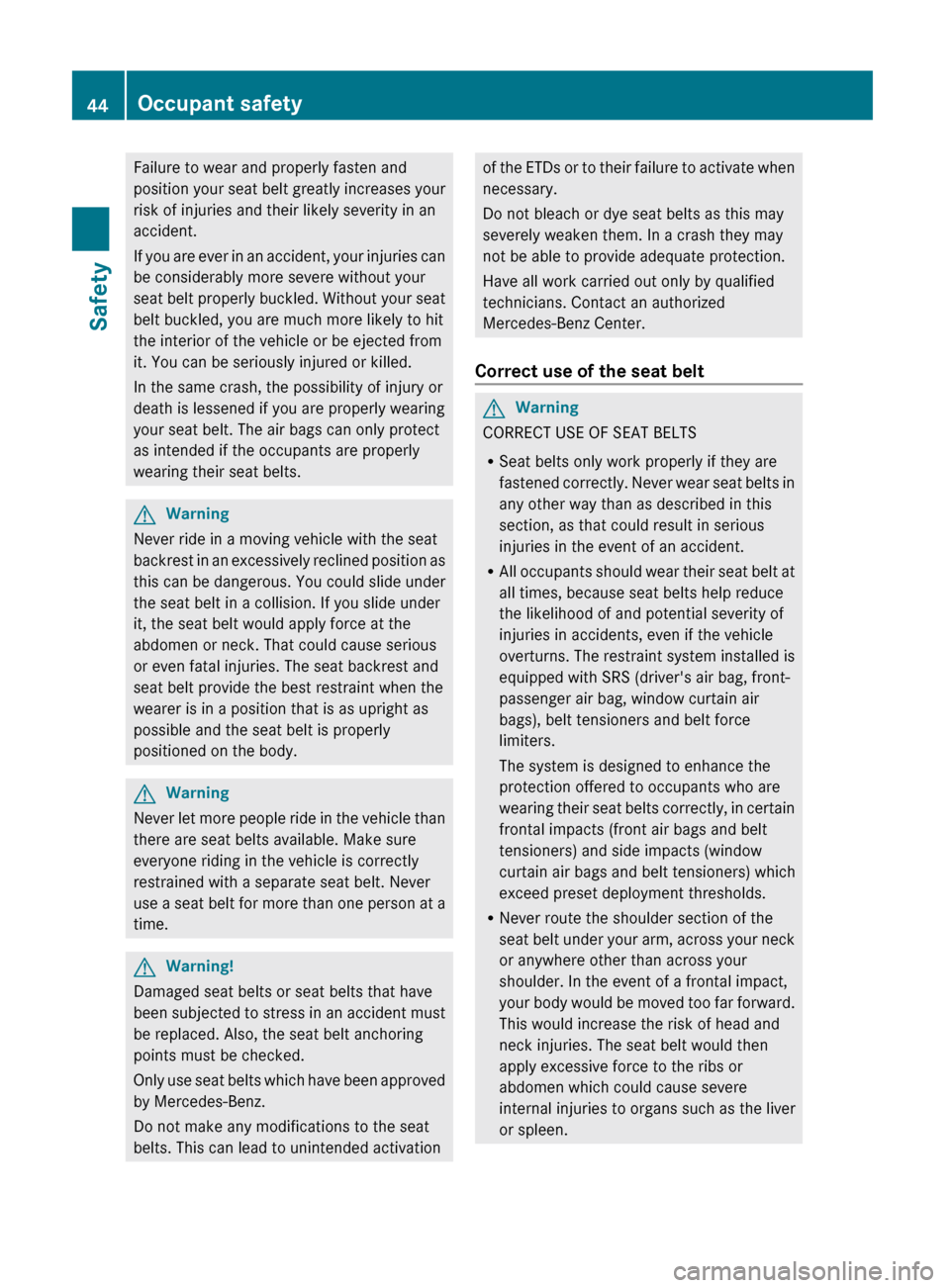
Failure to wear and properly fasten and
position your seat belt greatly increases your
risk of injuries and their likely severity in an
accident.
If you are ever in an accident, your injuries can
be considerably more severe without your
seat belt properly buckled. Without your seat
belt buckled, you are much more likely to hit
the interior of the vehicle or be ejected from
it. You can be seriously injured or killed.
In the same crash, the possibility of injury or
death is lessened if you are properly wearing
your seat belt. The air bags can only protect
as intended if the occupants are properly
wearing their seat belts.GWarning
Never ride in a moving vehicle with the seat
backrest in an excessively reclined position as
this can be dangerous. You could slide under
the seat belt in a collision. If you slide under
it, the seat belt would apply force at the
abdomen or neck. That could cause serious
or even fatal injuries. The seat backrest and
seat belt provide the best restraint when the
wearer is in a position that is as upright as
possible and the seat belt is properly
positioned on the body.
GWarning
Never let more people ride in the vehicle than
there are seat belts available. Make sure
everyone riding in the vehicle is correctly
restrained with a separate seat belt. Never
use a seat belt for more than one person at a
time.
GWarning!
Damaged seat belts or seat belts that have
been subjected to stress in an accident must
be replaced. Also, the seat belt anchoring
points must be checked.
Only use seat belts which have been approved
by Mercedes-Benz.
Do not make any modifications to the seat
belts. This can lead to unintended activation
of the ETDs or to their failure to activate when
necessary.
Do not bleach or dye seat belts as this may
severely weaken them. In a crash they may
not be able to provide adequate protection.
Have all work carried out only by qualified
technicians. Contact an authorized
Mercedes-Benz Center.
Correct use of the seat beltGWarning
CORRECT USE OF SEAT BELTS
R Seat belts only work properly if they are
fastened correctly. Never wear seat belts in
any other way than as described in this
section, as that could result in serious
injuries in the event of an accident.
R All occupants should wear their seat belt at
all times, because seat belts help reduce
the likelihood of and potential severity of
injuries in accidents, even if the vehicle
overturns. The restraint system installed is
equipped with SRS (driver's air bag, front-
passenger air bag, window curtain air
bags), belt tensioners and belt force
limiters.
The system is designed to enhance the
protection offered to occupants who are
wearing their seat belts correctly, in certain
frontal impacts (front air bags and belt
tensioners) and side impacts (window
curtain air bags and belt tensioners) which
exceed preset deployment thresholds.
R Never route the shoulder section of the
seat belt under your arm, across your neck
or anywhere other than across your
shoulder. In the event of a frontal impact,
your body would be moved too far forward.
This would increase the risk of head and
neck injuries. The seat belt would then
apply excessive force to the ribs or
abdomen which could cause severe
internal injuries to organs such as the liver
or spleen.
44Occupant safetySafety